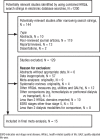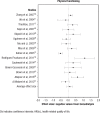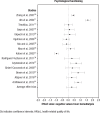Comparing Treatment Modalities for End-Stage Renal Disease: A Meta-Analysis
- PMID: 29910844
- PMCID: PMC5973249
Comparing Treatment Modalities for End-Stage Renal Disease: A Meta-Analysis
Abstract
Background: End-stage renal disease (ESRD) imposes significant economic and social burdens on patients and healthcare systems. In the United States alone, more than 600,000 Americans have ESRD, with an estimated annual cost of treatment of more than $30 billion. Peritoneal dialysis and hemodialysis are competing renal replacement therapies in ESRD; however, data comparing quality-of-life outcomes between these 2 modalities are limited.
Objectives: To compare the effectiveness of peritoneal dialysis with the more common treatment modality of hemodialysis on the health-related quality of life (HRQoL) of patients with ESRD in the general, physical, and psychological domains; and to determine whether the time of publication and the origin of each study influenced its findings regarding the effectiveness of the 2 modalities.
Methods: This meta-analysis followed the Preferred Reporting Items for Systematic Reviews and Meta-Analyses guidelines to collect the data. PubMed, MEDLINE, and PsycINFO were the primary databases searched. Only articles published in English were included in this meta-analysis. The measure of effect size was Cohen's standardized mean difference. A random-effects model was used to test the hypothesis of equality in the mean HRQoL.
Results: A total of 15 studies with a combined sample size of 4318 patients met the study criteria and were included in the analysis. The pooled effect sizes based on the random-effects model were 0.24 (95% confidence interval [CI], -0.17-0.66) in the general domain; 0.10 (95% CI, -0.09-0.29) in the physical-functioning domain; and 0.29 (95% CI, -0.13-0.71) in the psychological-functioning domain. None of the summary effect sizes was statistically significant. Subgroup analyses favored peritoneal dialysis regarding the time and country of publication.
Conclusion: The majority of the studies included in this analysis favored peritoneal dialysis over hemodialysis in all 3 domains. However, the pooled effect sizes were not significant, resulting in the inability to conclude that peritoneal dialysis is the more effective of these 2 treatment modalities.
Keywords: end-stage renal disease; health-related quality of life; hemodialysis; peritoneal dialysis; random-effects model; subgroup analysis.
Figures





References
-
- United States Renal Data System. 2016 USRDS Annual Data Report: Epidemiology of Kidney Disease in the United States. Volume 2: ESRD in the United States. 2016; National Institutes of Health, National Institute of Diabetes and Digestive and Kidney Diseases; Bethesda, MD.
-
- Szczech LA, Lazar IL. Projecting the United States ESRD population: issues regarding treatment of patients with ESRD. Kidney Int. 2004;66(suppl 90):S3–S7. - PubMed
-
- Kontodimopoulos N, Niakas D. An estimate of lifelong costs and QALYs in renal replacement therapy based on patients' life expectancy. Health Policy. 2008;86:85–96. - PubMed
-
- National Institute of Diabetes and Digestive and Kidney Diseases. Kidney disease statistics for the United States. December 2016. www.niddk.nih.gov/health-information/health-statistics/kidney-disease. Accessed April 16, 2018.
-
- Menzin J, Lines LM, Weiner DE, et al. A review of the costs and cost effectiveness of interventions in chronic kidney disease: implications for policy. Pharmacoeconomics. 2011;29:839–861. - PubMed
LinkOut - more resources
Full Text Sources
Miscellaneous
